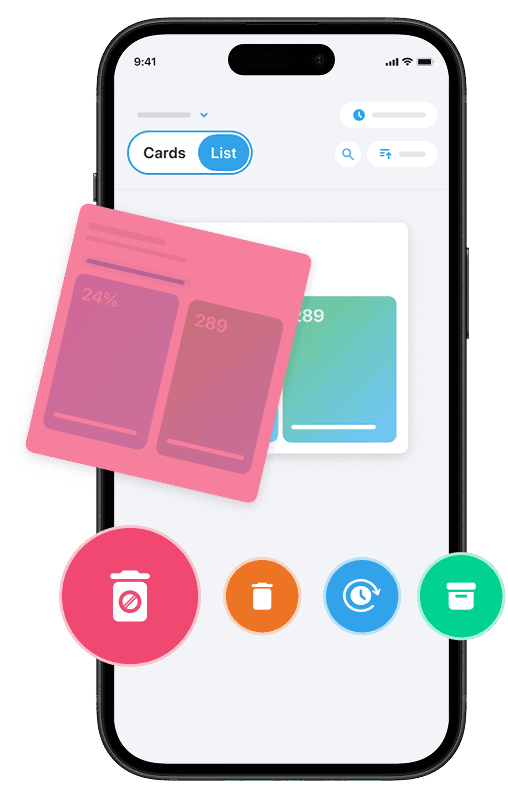If you’re wondering how to filter emails in Outlook, you’ve come to the right place. Managing your inbox efficiently is essential, especially in 2025 when the volume of incoming messages seems to never slow down. Fortunately, Microsoft Outlook offers powerful tools like rules, filters, and inbox management options to help you automatically organize and prioritize your emails.
Whether you want to sort messages by sender, set conditions to delete or move emails to specific folders, or create alerts for important communications, learning to create and customize these email rules will save you time and cut down on inbox clutter. In this step-by-step guide, you’ll learn how to create rules in Outlook that filter incoming emails to match your exact preferences, making your daily email management seamless and stress-free.
And if you’re aiming to spend less time glued to your screen, keeping your inbox free of spam is a great place to start — that’s where Cleanfox can help. Our free tool makes it easy to declutter your inbox so you can focus on what really matters.
Setting Up Basic Email Filters
Creating Filters Using Keywords
One of the easiest ways to start filtering your emails in Outlook is by using keywords. You can create a rule that looks for specific words or phrases in the subject line or the body of an incoming message.
To do this, select a message in your inbox, then click on Rules in the toolbar. Choose Create Rule and set conditions to trigger the rule when those keywords are detected.
For example, you could automatically move emails containing the word “invoice” to a designated folder. After choosing your conditions, select the action, such as moving the message to a folder or deleting it, then save your filter. This simple setup ensures that important topics catch your attention while less relevant emails are organized efficiently.
Step.1 ⬇️

Step. 2 ⬇️

Step. 3 ⬇️

Step. 4 ⬇️

Filtering Emails by Sender
Another fundamental way to filter emails in Outlook is by sender. This method is perfect when you want to organize messages from a specific person or source. Simply locate an email from that sender in your inbox, right-click on it, then select Find Related and click on Messages from Sender.
Outlook will instantly display all emails sent by that person, and you can use this to create a permanent rule by clicking on Rules and then Create Rule. Set the condition to filter messages from that sender and choose to move, flag, or even delete these emails automatically. This filtering method is highly effective for keeping your inbox tidy and prioritizing messages from key contacts.

Utilizing Date and Size Criteria
Basic Outlook filters also allow you to sort emails based on the date they were received or their size. For instance, you can set up a rule to auto-archive or delete emails older than a specific period, helping you maintain a clutter-free inbox.
Similarly, you can filter large emails that might be taking up storage space by setting size thresholds. To apply these, go to Manage Rules & Alerts, choose to create a new rule, and add the relevant conditions, such as messages received before a certain date or emails larger than a specified size in kilobytes. Then, assign an action like moving them to a folder or deleting them, and save your settings.
Leveraging these date and size criteria keeps your mailbox efficient and under control.
Advanced Filtering Techniques
Say goodbye to spam, clutter, and chaos.
Our smart email cleaner filters out junk, organizes your inbox, and helps you focus on what really matters.
✅ Block spam automatically
✅ Organize emails by priority
✅ Keep your inbox clean
✅ Clean old emails you don’t read
📱 Available on the App Store and Google Play.
Using Conditional Formatting for Visual Cues
Beyond basic rules, Outlook offers conditional formatting to help you manage your inbox visually. This advanced technique allows you to automatically change the font style, color, or size of emails based on specific criteria such as the sender, subject keywords, or importance level.
For example, emails marked as high priority or from your manager can stand out in bold red text, making them instantly recognizable as you scan your inbox. To set this up, open the View Settings menu, then click Conditional Formatting, and create a new rule with your desired conditions and formatting. This helps you quickly identify important messages without manually sorting through numerous emails.
Step. 1 ⬇️

Step. 2 ⬇️

Step. 3 ⬇️

Integrating Category and Priority Filters
Another powerful feature for advanced filtering is integrating Outlook’s built-in categories and priority flags. Categories let you color-code and label emails, making it easier to group related messages even before opening them.
You can create rules that automatically assign a category based on sender, keywords, or subject and combine this with priority settings to flag urgent emails. For instance, a rule could assign the “Project X” category and mark messages as “High Importance” whenever it detects specific keywords or comes from a key client. These filters can be customized both in the Outlook desktop app and Microsoft 365 versions, helping you streamline your workflow with meaningful visual markers.
Step. 1⬇️

Step. 2⬇️

Employing AI Suggestions for Filtering
Microsoft Outlook in 2025 embraces AI-driven features that suggest rules and filters based on your email behavior. The intelligent system learns from how you handle messages—such as which emails you frequently move, flag, or delete—and recommends automatic filters to improve your inbox organization. When you access the Rules or Manage Rules & Alerts section, Outlook may prompt you with suggested rules that can filter or categorize messages more effectively.
This use of machine learning saves you time by creating personalized inbox filters without manual setup, ensuring your email management evolves with your habits and priorities.
Managing and Maintaining Filters
Editing and Deleting Existing Filters
Once you have created several email filters in Outlook, it’s important to periodically review and adjust them to stay organized efficiently. To edit or delete an existing filter, open Outlook and go to the Manage Rules & Alerts section.
Here, you will see a list of all your active rules. Select the rule you want to modify and click Edit Rule Settings.
This will bring up the rule wizard where you can change the conditions, actions, or exceptions for the filter. If a filter is no longer needed, simply select it and click Delete.
Removing outdated or redundant rules keeps your inbox running smoothly and prevents conflicts between multiple filters.

Synchronizing Filters Across Devices
In today’s multi-device world, keeping your Outlook email rules synchronized is essential. If you use Outlook on your desktop, mobile device, and through the web, you’ll want your filters to be consistent across all platforms. Microsoft Outlook automatically syncs server-side rules for accounts like Outlook 365, ensuring that email filters are applied no matter how you access your inbox.
However, client-side rules may only operate on the device where they were created. To maximize synchronization, use cloud-based Outlook accounts and create rules directly through the Microsoft Exchange server interface.
This way, your inbox rules work seamlessly on every device you use.
Automating Filter Reviews for Efficiency
To maintain an efficient email system, consider scheduling regular reviews of your Outlook filters. You can automate reminders or tasks to check your current rules, ensuring they are still relevant and effective.
Over time, your email habits and priorities may change, and so should your filters. Regular maintenance helps you spot and remove obsolete conditions, consolidate similar rules, and update actions to reflect your workflow. By automating this review process, you’ll avoid filtering buildup, reduce missed important messages, and keep your email outlook organized proactively.
Step. 1⬇️

Step. 2⬇️

Conclusion 💡
Filtering emails in Outlook is a powerful way to take control of your inbox and boost productivity. By creating rules based on keywords, senders, dates, and size, you can automatically organize your incoming messages with minimal effort.
Advanced techniques like conditional formatting and AI-driven suggestions further refine your email management. Remember to regularly review, edit, and sync your filters across devices to keep your system efficient. Now that you understand how to filter emails in Outlook effectively, take action today to customize your inbox and enjoy a clutter-free, streamlined email experience.
FAQ 📘❓
How can I create custom email filters in Outlook to automatically organize incoming messages?
To create custom email filters in Outlook, open either the web or desktop version. Navigate to Settings and locate the “Rules” section. Click “Add new rule,” give it a name, set conditions such as sender or subject, and choose an action like moving the message to a specific folder. Finally, save the rule to activate the filter. This process helps efficiently automate the organization of incoming emails.
What should I do if important emails are mistakenly marked as spam or junk by Outlook filters?
If important emails are mistakenly marked as spam in Outlook, start by opening the Junk Email folder. Select the affected emails and choose “Mark as Not Junk” to move them back to your inbox. To prevent future occurrences, add the sender to your Safe Senders list. If the emails have been deleted, you can try recovering them from the Deleted Items folder.
Additionally, review and clear any blocked sender lists to ensure normal email flow.
How do client-side rules differ from server-side rules in Outlook’s filtering system?
Client-side rules in Outlook operate only when the application is open on your computer. These rules can perform actions like moving emails to local folders or adding categories. On the other hand, server-side rules run directly on the Exchange server, applying actions such as moving or copying emails immediately upon arrival, regardless of whether Outlook is open.
What are best practices to prevent my legitimate emails from being flagged as spam by Outlook?
To prevent legitimate emails from being flagged as spam by Outlook, use a reputable email domain and maintain a strong sender reputation. Avoid spammy content, regulate your email sending frequency, and craft clear subject lines. Stay away from spam-trigger keywords, engage recipients meaningfully, and maintain clean email lists with opt-out options.
Additionally, whitelist trusted senders, use Outlook’s safe sender list, and block suspicious senders. Compliance with laws like CAN-SPAM is necessary. To reduce spam triggers further, disable unnecessary read receipts and automatic external content.
Found this article helpful? Keep mastering your email with our post: “Is Junk Email the Same as Spam? (2025 Guide).” Don’t forget to explore our blog for more practical tips!



